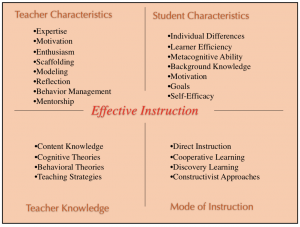The keys to effective instruction are:
- knowledge
- planning
- assessment
- creating a productive learning environment
- evidence-based practices
Technology can be used to assist all of these essential strategies!

PLANNING
When planning, consider:
- Students’ age and grade level
- Prior knowledge or life experiences of your students
- The skills you want your students to acquire
- By making technology a skill that is always included, you are preparing your students for the 21st century
- Instructional goals (long-term outcomes of instruction)
- Instructional objectives (specific outcomes of a lesson)
TASK ANALYSIS
Identifying the essential behavioral or cognitive aspects of mastering a particular topic or skill.

Using task analysis,
- Helps you define what students need to do and the order in which they can most effectively learn
- Guides your selection of appropriate instructional strategies
- Helps you determine the kind of cognitive load a task might impose on students (e.g. working memory capacity)
- Helps you to consider student motivation
Teacher Directed Instructional Strategies
A teaching model designed to help students acquire well-defined knowledge and skills needed for learning.
Particularly effective when teaching content/procedural skills have:
- Specific sets of identifiable operations or procedures
- Can be illustrated with a large and varied number of examples
- Can be developed through practice

Student Directed Instructional Strategies
- Discovery Learning
- Students derive information for themselves.
- Things like google and iPads are significant aids for students doing discovery learning.
- Inquiry Learning
- Helping students acquire more effective reasoning processes either instead or in addition to acquiring new information.
- VR and AR are great tools for inquiry learning.
- Problem-based Solving
- Students work in group to confront a real-world, ill-structured problem that has no single correct solution.
- There are various video games throughout the internet that are educational and use collaboration– power-points and prezi’s are just two examples.
- Cooperative Learning
- Students work in small groups to achieve a common goal.
- Collaborative Learning
- Students take various positions on an issue and present evidence to argue for their positions.